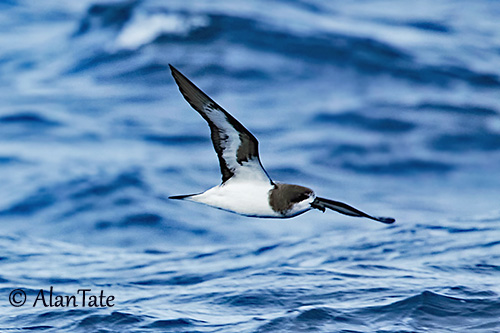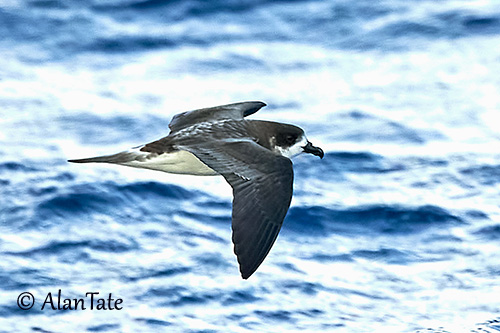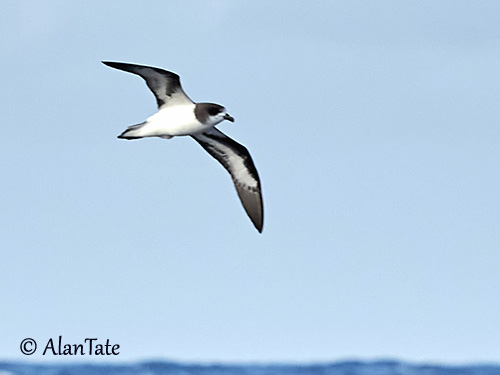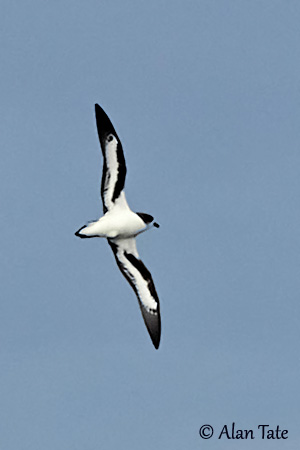
Bermuda Petrel
Pterodroma cahow
Procellariiformes Order - Procellariidae Family
INTRODUCTION:
The Bermuda Petrel or Cahow (its name on Bermuda) has been rediscovered on January 28, 1951, during a survey of the islets around Castle Harbour where several nesting pairs were established.
The Bermuda Petrel is also called “Lazarus species” because it appears to return from the dead, like the biblical Lazarus. The name “Cahow” comes from its eerie cries.
This species is pelagic and rare near land, but it breeds on small offshore rocky islets. The Bermuda Petrel nests in a burrow excavated by the birds themselves, although today, most birds nest in artificial burrows in order to maximize their breeding success. Both parents share the nesting duties.
They feed on squid and shrimps and probably small fish. They forage mainly over deep waters.
The Bermuda Petrel’s population was first destroyed by human settlers and introduced mammals in 16th and 17th centuries, but the greatest threat to the survival of the species occurred in the middle 20th century, caused by pesticides, and especially DDT.
Thanks to protection, nesting-ground management, eradication of introduced predators and reforestation of the nesting islands with native flora, the population has increased of 79% in three generations, but it is currently listed as Endangered, with less than 100 nesting pairs.

DESCRIPTION OF THE BIRD:
Biometrics:
Length: 35-38 cm
Wingspan: 89 cm
Weight: M: 278-454 g – F: 258-413 g
The Bermuda Petrel is a medium-sized gadfly-petrel (See: Family Procellariidae – Paragraph: The gadfly-petrels’ group). Male and female are similar.
Top of head and body are dark grey, whereas wings and tail are almost black. We can see a pale area on the rump, just ahead of the tail. The M pattern is conspicuous in flight.
The underparts are white. On the underwing, both leading and trailing edges are blackish, the leading edge being broader. The flight-feathers are dark grey to blackish. The axillaries are white like the internal area of the underwing.
The white undertail-coverts are very long.
On the head, crown and nape are dark grey, and this area extends to the side of neck and breast, giving the bird hooded appearance. Throat, chin and the area above the bill are white.
The hooked bill is black with tubular nostrils.
The eyes are dark brown.
Legs and webbed feet are bicoloured, being blackish towards the claws, and dull pinkish (or orange-pink or greyish-pink) while joining the tarsus which is dull pale pink.

The chick is covered in pale grey, dense down, except around bill base and eyes where the bare skin is white.
Juvenile and subadult resemble adults, but with more contrast above. The greyish tones are paler than in adults, with more pronounced M pattern above.
RANGE:
The Bermuda Petrel nests only on six small islands off the southeast part of Bermuda, around Castle Harbour. These islands are Horn Rock, Long Rock, Inner Pear Rock, Green Island and more recently Nonsuch Island.
The former nesting island Outer Pear Rock is no longer used. The last nesting Bermuda Petrels on this island were killed by the Brown rat in 1977-1978.
Now, the Castle Harbour Islands have become Nature Reserve and National Park.
Outside of breeding season, the species probably disperses N or NW in subtropical Atlantic while following the warm parts of the Gulf Stream.
There are confirmed records off coast of North Carolina (USA) and some birds reach even further N, off Atlantic Canada. A juvenile was seen 290 kilometres off Massachusetts in June 2009. One bird was captured twice in the same burrow on a small islet on the Azores in November 2002. Another was photographed W of the Co. Kerry, Ireland, in mid-May 2014.
But we can suggest that most of them forage close to Bermuda during the breeding season.
HABITAT:
The Bermuda Petrel is pelagic outside of the breeding season.
It breeds on rocky offshore islets with available nesting burrows and cavities. It was formerly established in large numbers inland, on hillsides and sandy dunes on the main island. They excavate the burrows themselves where there is topsoil. But now, they often use artificial burrows.
CALLS AND SONGS: SOUNDS BY XENO-CANTO
The gadfly-petrels usually remain silent at sea, but they become very vocal at night while visiting their breeding grounds.
The adult returning to the nest-site produce short, high-pitched contact calls described as a single soft, creepy note, or loud, scratchy “eet” sounds. While on the nest, the birds give shorter calls, sounding like a whining puppy.
The birds often vocalize during the courtship displays, and typically in pairs. The male flies ahead of the female while producing a high “oooooooooooo-EEK” and the female responds with a lower-pitched growling or moaning “aaaaaaaawww-AK”. We can also hear series of yelping “EEK” probably from males, but more information is needed.
On the nesting grounds, the birds vocalize mainly in the late afternoon and during the night.
The calls of the females are lower-pitched than those of the males.

BEHAVIOUR IN THE WILD:
The Bermuda Petrel feeds mainly on squid and shrimps, but it also takes variable proportions of small fish, crustaceans and other invertebrates.
Squid and fish are caught live at night, while the bird is flying just above the waves. A minor proportion of prey is scavenged at sea.
The gadfly-petrels feed mainly on the wing by dipping while in flight. They are mainly solitary feeders.
The Bermuda Petrel is a monogamous species. During the courtship displays, male and female duet in flight while chasing each other.
The nest-site is prepared by the male and then, the female visits the site with her mate. When both adults are at the nest inside the burrow, they often perform mutual preening. The male also feeds the female prior to the laying.
But some problems may occur caused by the competition for nest-sites with the White-tailed Tropicbird which returns to nest in early spring, when the chicks of the Bermuda Petrel are still several months away from fledging. The Tropicbirds kill and remove the chicks, and use the nest-site.
In order to protect the petrel chicks, wooden baffles were built to cover the burrow entrance. The small aperture does not allow the larger Tropicbirds to enter the nest-site.
The Bermuda Petrel nests in loose colonies established on rocky islets, and the nest is built in crevice or burrow, including artificial ones. Both parents share the nesting duties.
The migration of the Bermuda Petrel is poorly known, but it probably disperses N or NW in subtropical Atlantic, following the warm parts of the Gulf Stream (See above: RANGE).
The Bermuda Petrel is often detected while it is flying. The gadfly-petrels fly swiftly in wide arcs above the sea, as if pursued by a gadfly!
They usually fly fast, sometimes low over the water, or by wheeling up into the sky, or “towering”. They perform rapid wingbeats interspersed with glides.
They alight rarely on the water but they may sometimes rest on the water, close to the breeding colonies. They are clumsy when on land.

REPRODUCTION OF THIS SPECIES:
The breeding season takes place from October to June. In December, the adults remain at sea. The female prepares for egg-laying and forages heavily.
The Bermuda Petrel nests on four small rocky islands fringing the E of Castle Harbour, Bermuda. They are composed of soft limestone and are eroded. The vegetation is sparse and the soil only occurs in isolated patches.
Like in other species of genus Pterodroma, the breeding biology of the Bermuda Petrel includes a pre-laying exodus from the nesting grounds, a single egg per year is laid, long incubation bouts by both adults, and a long fledging period.
The Bermuda Petrel nests in natural or artificial burrow. The nest itself is built at the end of the tunnel. It is a bare scrape sometimes lined with grasses or other plant material.
The female lays a single white egg. Incubation shifts are frequent but rarely seen. From an observation, one of the parents buried the egg before leaving the nest. Soil and debris were pushed from the tunnel by using both breast and wings, in order to cover the egg. This behaviour is unknown in petrels.
The incubation by both parents lasts 51-54 days with stints of 8-14 days. The chick is brooded for the first 1-2 days. It fledges 90-100 days after hatching.
The adults visit the burrow only at night. They forage at sea to provide food for the chick. They may travel over long distances from the nesting site to the foraging areas. The food is carried back in the crop, and regurgitated to the chick.
The young bird comes out at night to flap its wings prior to the departure. During the day, it remains at nest. Usually, about 6-15 days after its parent’s desertion, the juvenile flies out to sea on its own. It fledges by May or early June.
During this period, numerous predators congregate near the colony. There are Laridae (Gulls), Stercorariidae (Skuas), Corvidae, and Birds of Prey. In addition, too long distance to the sea, attraction by lights and violent weather are the main threats during the way to the sea.
PROTECTION / THREATS / STATUS:
The Bermuda Petrel or Cahow is Bermuda’s National Bird.
These birds were abundant before colonisation, and were seen everywhere during the breeding season. But the population rapidly declined in numbers, and the species was considered extinct for 300 years.
But in 1951, Robert Cushman Murphy and Louis Mowbray discovered seven pairs of breeding birds. In 2006, 76 pairs were recorded, but the recovery has been slow. It was credited to Dr. David Wingate and Jeremy Madeiros.
The creation of artificial nesting burrows, later modified by inclusion of a wooden baffle to protect the petrels against the White-tailed Tropicbird, played an important role in population’s increase.
Other threats included predation by introduced species such as rats, cats, dogs and pigs, and direct hunting for food. But today, these invasive species are controlled and managed.
The threat of sea-level rise and increasing storm activity with hurricanes also affect the populations.
The intense lights from the international airport cause disruptions to Bermuda Petrels on their breeding islets, but this problem is now managed to reduce the impact.
The Bermuda Petrel or Cahow is the best known endemic species of Bermuda. The recovery of the population is celebrated as a world-wide triumph of conservation.
The nesting islands have been protected as a Nature Reserve since the 1960s.
A new nesting colony was established on Nonsuch Island, and by 2016, the colony has grown to 15 nesting pairs. Between 2009 and 2016, this colony has produced 46 successfully fledged chicks.
The population reached 98 nesting pairs in 2011. It has increased from 18 pairs in 1951 to 71 pairs in 2005, and 98 in 2011.
This species also has an increased risk of extinction caused by its restricted range, small population’s size and low genetic diversity. But this population remains extremely small, and the Bermuda Petrel or Cahow is currently listed as Endangered.
Fr: Pétrel des Bermudes
Ang: Bermuda Petrel
All: Bermudasturmvogel
Esp: Petrel Cahow
Ita: Cahow
Nd: Bermudastormvogel
Sd: bermudapetrell
Photographers:
Alan & Ann Tate
AA Bird Photography
Text by Nicole Bouglouan
Sources:
HANDBOOK OF THE BIRDS OF THE WORLD vol 1 by Josep del Hoyo-Andrew Elliot-Jordi Sargatal - Lynx Edicions - ISBN: 8487334105
Birder's Conservation Handbook: 100 North American Birds at Risk by De Jeffrey V. Wells – Editor: Princeton University Press, 2010 – ISBN: 1400831512, 9781400831517 – 464 pages
Birds in Trouble De Lynn E. Barber – Editor: Texas A&M University Press, 2016 – ISBN: 1623493595, 9781623493592 – 224 pages
Bermuda Petrel, Thought Extinct for 300 Years, Re-discovered (1951)
Remote Ornithology: Studying Nesting Behavior of Bermuda Petrels via Live Webcam
Breeding biology and population increase of the Endangered Bermuda Petrel Pterodroma cahow
South Dakota Birds and Birding – (Terry L. Sohl)
Wikipedia, the free encyclopaedia